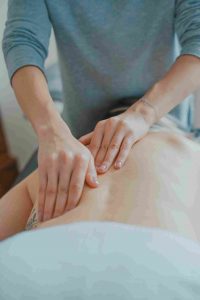What is Torticollis or Cervical dystonia?
Torticollis, from the Latin word meaning “twisted neck” or “wry neck,” is a neurological disorder that causes involuntary muscle spasms in the neck, resulting in the head turning, twisting, or tilting to one side. It falls under the category of dystonia, a group of neurological diseases characterized by abnormal muscle contractions. Torticollis is classified as a “focal dystonia,” affecting only one part of the body.
While a rare disorder, affecting only 1500 out of 6 million people in Denmark, Torticollis is more prevalent in women between the ages of 40 and 50. The condition often develops slowly, with a slight head tilt while performing daily activities such as walking, reading, or driving. Many individuals are unaware of the disorder until friends or family bring it to their attention. Initially, the head rotation may occur only occasionally but becomes more constant over time. It can take an average of 2 years to receive a proper diagnosis in Denmark.

Is recovery possible?
The answer is ABSOLUTELY YES!
While the theoretical field about dystonia is still missing a certain explanation about the cause, more and more empiric experiences shows that dystonia and thus Torticollis can be eliminated with the rigtht exercises.
A lack of knowlegde
At the time when Torticollis is diagnosed most people all over the world will probably get the statement that the disease is a chronical and lifelong condition that cannot be cured or improved. This statement is nessecarily said because of the lack of theoretical knowlegde of what exactly is going on in the brain.
Stress as a cause
Newest studies assume that stress is the main cause of Torticollis, paralyzing nerve signals from either the right or left side of the brain – resulting in a lack of muscle response and movement in one side – which gives the head turning. This thesis is based on the knowlegde about that the human body got two systems in the autonomic nervous system.
- The Fight / Flight /Freeze system (Sympathetic) is a kind of gas pedal which provides the body with energy to overcome perceived dangers.
- The Rest and Repaire system (Parasympathetic) slows down everything allowing the body to experience a more relaxed state.
When having Torticollis, the Fight /Flight/ Freeze system is dominant while the Rest and Rstore system isn’t working normally. It is well known that stress can cause many physical symptoms – some of the most severe are cramped muscles – which leads to Dystonia / Torticollis – probably for persons who are some how predisposed.
Breaking out the vicious circle of stress
As a vicious circle Torticollis is not only produced by stress. It is also producing more stress.
Thus when it is possible to recover from the torticollis symptoms it is a matter of getting out of the negative circle of stress. More and more practioners in the world discovers that exercises that provide a relaxed state in the neck will lead to a improvement or full recovery from Torticollis. The improvements are gained by an active effort.
What is the Torticollis Recovery Program?
The Torticollis Recovery Program is based on a unique collection of the most powerful excercises that gives a proven effect of elimating Torticollis symptoms.
The program is primarily based on Nelis experience with recovering with physical exercises. In addition, 10 years of experience of helping people with Torticollis, the program is tailored to each persons ablility, symptoms, conditions and comfort level. The program is constantly improved and specialized with more nuanced advice and exercises.
Besides instruction of exercises and massage, the program is providing advice about how to move your neck in everyday life. This includes mental tools reducing stress, and getting more of the relaxing activities.
